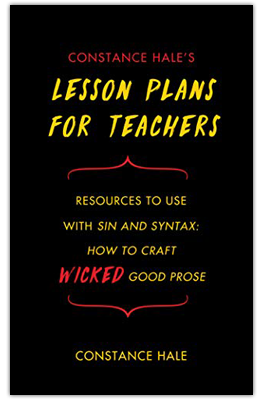Resources for YOU!
My gift to writing teachers
I’ve recently turned a longtime dream into a reality, publishing a book of lesson plans for teachers who use Sin and Syntax in the classroom. This is something I have been working on since 2008. I kept adding to the lesson plans, teaching more workshops, expanding my dream, and imagining the day when I would stop tinkering, seriously edit them, find a copy editor, and put the materials into some more credible form than a Word document.
 This material is now an e-book. It’s called Constance Hale’s Lesson Plans for Teachers, and is available on multiple digital platforms. (See below.) It is two semester-long suites of lesson plans—part of my dogged attempt to change the way we think of sentences, syntax, and literary style. Or maybe just to make writing less anxiety-filled and more joyful.
This material is now an e-book. It’s called Constance Hale’s Lesson Plans for Teachers, and is available on multiple digital platforms. (See below.) It is two semester-long suites of lesson plans—part of my dogged attempt to change the way we think of sentences, syntax, and literary style. Or maybe just to make writing less anxiety-filled and more joyful.This is my gift to teachers, on whom we depend to keep our society well-informed, well-spoken, curious, expressive, and maybe even eloquent. I am keeping the cost as low as possible to make it widely available. Its 372 pages come with ideas for discussions, in-class exercises, homework assignments, handouts, answer keys, and even a big grammar test. There are readings galore, of my heterodox favorite passages (from Charlotte Brontë to Muhammad Ali!). And the handouts that go along with the lessons are downloadable as a PDF, so that you can give them to students. Interested? Learn more here. Go straight to the handouts here.
Here are links to the sites that sell it, at an introductory price of $6.99:
Hemingway’s “Hills Like White Elephants” is quoted in the e-book. So I’ll borrow from him: Would you please please please please please share this news, widely and wildly? With teachers, with parents of adolescents, with school administers, with anyone you know who teaches writing or grammar or even language arts?

The motivating idea of all my language books is that we are all born with the gift of language and the love of words. This early infatuation (the cooing and the babbling, the riddles and the rhyming, the love of nonsense and the taste for the slightly scatological) is often beaten out of us. I don’t want to assign blame, but there are many wrongheaded ideas floating around about what is “correct” and what is “incorrect,” what is “standard” and what is “nonstandard.” There are too many red pens and too few opportunities to cut loose and play. So I thank you for reading this e-book, using this e-book, and adapting it to your own needs. Please keep insisting that your wards rediscover that early love for the way words work—on the page and in the air.
I’m happy with the outcome, and to close I’ll share what some of my colleagues and teaching heroes have to say about the book:

Hot damn. Finally. Finally, after years of nodding off and flat out flatlining to dozens upon dozens of grammar books that land like a gavel on my desk as a teacher, I found a craft book every bit as electric as grammar should be. Truly, I haven’t had this much fun thinking about parts of speech since bebopping to Schoolhouse Rock! when at six I sat inches from the television screen singing “Conjunction Junction.” But here you have no elementary take on grammar. No, Hale proves time and again that the rules of language belong not to those who love rules but language itself. This is no stiff tome but a romp in Hale’s own kind of amusement park where word-weary students can stuff themselves silly on every adjective salty and sweet, where they can take themselves on a joyride of syntax just as wild as real speech, where they can begin to understand grammar for what it really is—a bawdy engine of movement and verve. With a sharp eye towards both standardized English and street-wise vernacular, Sin and Syntax proves that if you ever found grammar boring, it was the fault of the teacher and not the grammar itself. Most importantly, this guidebook is the best tool I’ve found to show students that the rules that govern writing are no more static than the living dynamos from which language is made and remade everyday—human culture and synapse and breath.
—Nickole Brown, professor of creative writing, Sewanee School of Letters MFA, and author of Sister and Fanny Says

When I write about good writing, works by Constance Hale are high on the lists I recommend. She has the unique capacity to teach language strategies that are centuries old and adapt and apply them to the digital age. Her dogged creativity has now given us something more: a set of lesson plans for teachers. I have written a bunch of books on writing and language. You will find lessons in them, but not a precise, coherent path of learning that teachers can present to students—some eager, others not so much. This e-book is an act of generosity you will rarely find in a world where some textbooks cost more than $100. Not only is Connie virtually giving away the digital version, but she is inviting teachers to photocopy the handouts so that students can have them for free and then apply the lessons. When I was in high school, I bought copies of Mad magazine, a satirical work for young wise guys like me—and some wise girls. The cost of each issue was 25 cents. Underneath that price was the word Cheap! It was a compliment back then, and Connie has brought back that playfulness and generosity, helping teachers lead students down a path of discovery that covers not only the conventions of language but also the spirit that turns reluctant readers and writers into lifelong learners. Buy her books, and use these lesson plans.
—Roy Peter Clark, author of Writing Tools: 55 Essential Strategies for Every Writer

If Grammar and Wit had a child, it would be Sin and Syntax. Constance Hale’s imaginative voice and protean methods turn the craft of writing into an exciting, risk-taking enterprise. Hale covers an extraordinarily broad range of topics—from nouns to narrative style, from pronouns to parataxis. The teacher's guide includes comprehensive exercises and easy access to a stellar array of examples in literature. Because the structure of the guide is flexible, teachers can gear lessons to students at different levels. Hale invites teachers to give feedback, illuminating her grasp on the kinetic nature of language and the fact that grammar is always a work-in-progress.—Thaisa Frank, author of Heidegger’s Glasses and coauthor ofFinding Your Writer’s Voice

Glad tidings for writing and composition educators! A teaching guide using Constance Hale’s famously hip and heartfelt approach to grammar, style, and voice—overflowing with unique ideas, prompts, and lively passages. Driven by Hale’s love of word-power, it’s further informed by her many compassionate workshops for writers at all levels. A smashingly helpful and pleasurable way into better writing and the teaching of it.
—Arthur Plotnik, author of Spunk and Bite: A Writer’s Guide to Bold, Contemporary Style

For anyone who hated grammar as a kid and struggles with writing today, Constance Hale is your friend. She makes learning to write approachable, intelligible, and entertaining. She has combined her many years of experience into these lesson plans, an essential resource for anyone who teaches writing, and wants to share the love of language with students.
—Laura Fraser, journalist, author of An Italian Affair and writing teacher at The Writers Grotto

Constance Hale’s terrific lesson plans give practical, fun ideas for elucidating basics and more sophisticated elements of style in the classroom. I wish I’d had this guide when I taught composition, and I will borrow more than a few ideas here for teaching voice and tone, especially. What other guide gives examples from both Charlotte Brontë and Muhammad Ali? Highly recommended.
—Lindsey Crittenden, author of the memoir The Water Will Hold You and honored instructor in writing, UC Berkeley Extension

When young people truly understand the nuances of English grammar, they truly understand the elements of transformative speaking, writing, and thinking. Nothing could be more important in this moment of our history. Engaging, elucidating, and entertaining, Constance Hale’s Lesson Plans for Teachers is a must for any teacher who cares to make a difference in education.
—Steven Laffoley, award-winning author, teacher, and headmaster of the Halifax Grammar School in Nova Scotia

Constance Hale understands how to captivate young minds. Students so often ask about grammar’s relevancy. She provides answers galore and makes grammar fun at the same time. But she does more than that. She helps build strong writers by showing students the nuances of sentences. This should be required reading for high school English and college composition teachers, who will be thankful to have discovered Hale’s lesson plans.
—Alexa Hunter, M.A., English teacher in the Los Angeles Unified School District
| |
Share This:





